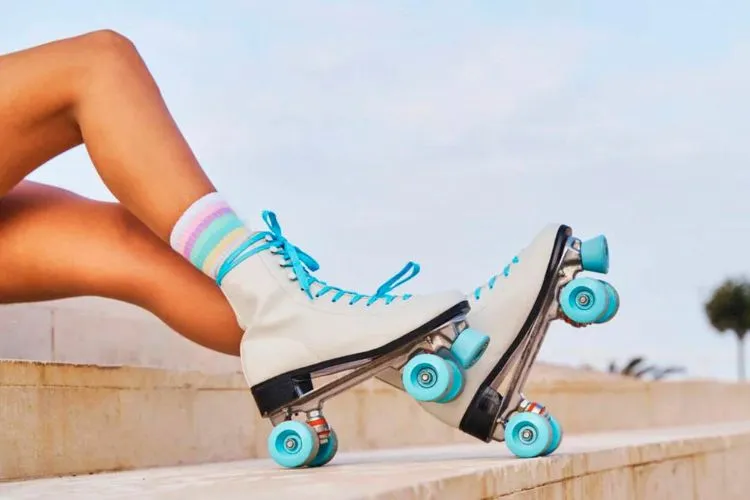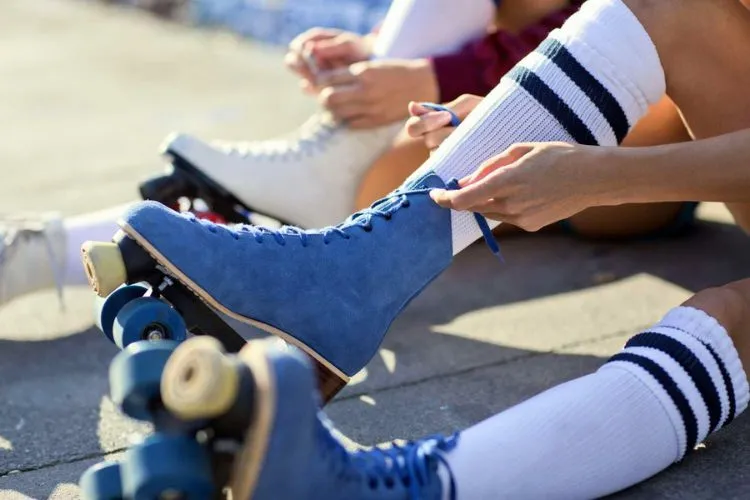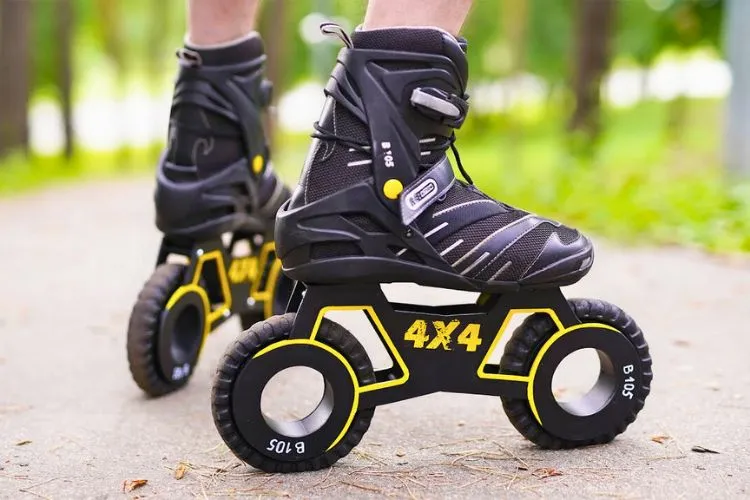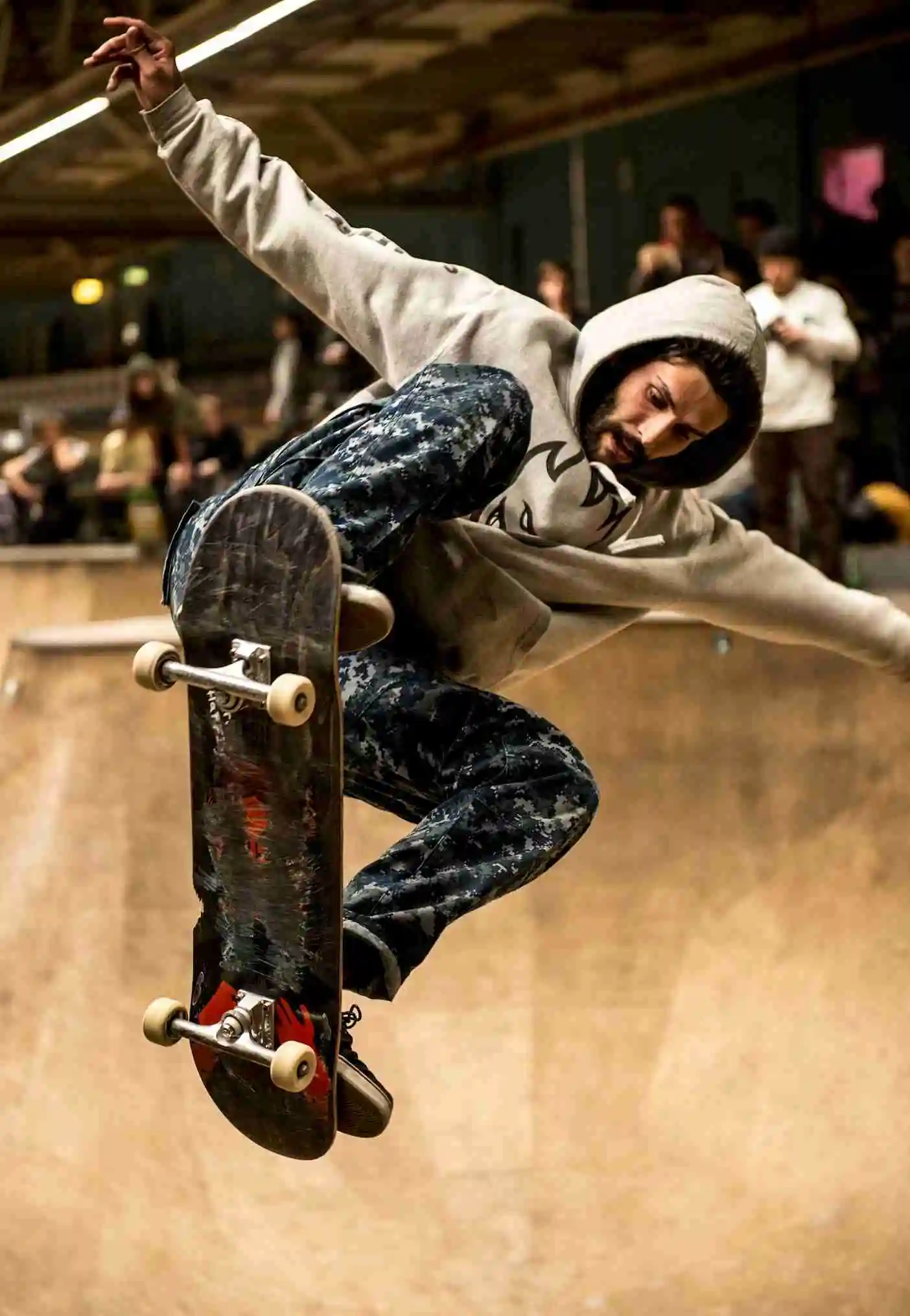Tying roller skates correctly is crucial for performance and safety. Proper technique ensures comfort, stability, and prevents injuries during skating.
This detailed guide will teach you how to tie roller skates efficiently, whether you’re a beginner or an experienced skater.

Understanding Roller Skate Parts Relevant to Tying
- Boots: The boot of a roller skate holds your foot and interacts directly with the laces. Having a good fit is essential, as it directly affects lace tension and overall comfort.
- Laces: Laces can be made from various materials, including cotton and synthetic fibers. They come in different lengths and widths, which affect their functionality and durability.
- Eyelets and Hooks: Eyelets are the holes through which you thread the laces. Some skates also have hooks that help secure the laces around the ankle, providing additional support.
How to Tie Roller Skates?
Before you start tying your skates, make sure they fit well. Check your lace condition to ensure they aren’t frayed or too stretched.
Threading the Laces
Start at the toe area and insert each end of the lace through the bottom eyelets. Pull both ends to make sure the lace is even. Choose between cross-lacing and straight-lacing methods depending on your preference and the fit you need.
Tightening the Laces
Begin tightening the laces from the bottom, pulling each cross snugly. Ensure the tension is even across the foot to avoid discomfort.
Locking the Heel in Place
To ensure your heel doesn’t slip, pay extra attention when lacing around the ankle area. Use hooks if your skates have them, pulling the laces tight to secure the heel.
Tying the Knot
Once the laces are snug and the skate feels secure, tie a standard bow knot. For added security, a double knot will prevent the laces from coming undone.
Final Adjustments
Stand up and roll slightly on your skates. If you feel any discomfort or areas where the skates feel loose, sit down and adjust the tightness.
Tips for a Perfect Tie
Finding the right balance between comfort and tightness is paramount. Your skates should feel snug without cutting off circulation. Consider different lacing patterns if you have specific needs, like wider feet or high arches.
Selecting the appropriate lace length is also crucial. Short laces might not allow adequate tightening, while very long laces can create bulk that interferes with skating.
Troubleshooting Common Issues
If you find the laces loosening while you skate, try using a tighter knot or consider switching to waxed laces, which are less prone to slipping.

Should you experience pressure points, re-adjust the tension across the areas where discomfort occurs. Replace your laces regularly to avoid unexpected breaks or accidents.
Lacing Techniques Variations
When it comes to securing roller skates, the right lacing technique can make a significant difference in fit and comfort. Traditional crisscross lacing is commonly used, but other methods like heel lock lacing can provide enhanced ankle stability.
In heel lock lacing, the lace is looped through the backmost eyelets before crossing over, effectively “locking” the heel in place and reducing slippage. Another variation is loop lacing, also known as “runner’s loop,” involving creating loops with the laces at certain eyelets and threading the lace through these loops to pull the skate tighter in specific areas.
This is particularly beneficial for those with high arches or narrow feet, as it allows for more precise tension adjustment. Exploring these lacing techniques can lead to a better-customized fit, reducing foot fatigue and providing optimal support for your skating style.
You may also read: How to Clean Roller Skate Wheels? | How to Stop on Roller Skates?
Customization for Comfort and Style
Roller skating is not just about speed and agility; it’s also a form of self-expression. One of the simplest yet effective ways to personalize skates is through the use of colored and patterned laces.

Skaters can choose laces that match their team colors, reflect their personal style, or even change them seasonally. This small customization can make skates stand out and express individuality on the rink.
Beyond aesthetics, comfort is crucial in roller skating. Adding extra padding around the ankle area can reduce the risk of blisters and sore spots, particularly during long skating sessions. Moreover, investing in custom insoles can greatly enhance comfort.
These insoles can be tailored to individual foot contours and provide better arch support, distributing weight more evenly and improving overall foot health. Together, these adjustments not only elevate the look of the skates but also significantly boost performance and endurance.
Pro Tips
Using waxed laces can significantly improve grip and minimize slipping, providing a smoother experience. Learn how to tie a surgeon’s knot for extra tightness at specific points, such as the ankle bend. Always keep an extra pair of laces in your skate bag for emergencies.
Safety First
Properly tied skates are essential for preventing foot and ankle injuries. Good ankle support is crucial, especially if you engage in aggressive skating or tricks.
Frequently Asked Questions (FAQs)
Can I use any type of lace for my roller skates?
Not all laces are suitable for every skate or skater. Choose laces that match the design and fit requirements of your skates.
How often should I replace my roller skate laces?
Inspect your laces regularly for wear and tear. Replace them when they show signs of fraying or when they lose elasticity.
What do I do if my skates feel too tight or too loose even after tying them correctly?
Re-evaluate your lacing technique. Adjust the tightness or lacing pattern to provide a better fit. If issues persist, consult with a skating professional.
Are waxed laces better than non-waxed laces? Why?
Waxed laces tend to hold their position better because they grip eyelets more firmly. They are particularly useful for skaters who need their laces to withstand a lot of movement.
How can I prevent my laces from coming undone while skating?
Double knotting helps. You might also try lace locks or other aftermarket products designed to keep laces tied during intense activity.
Conclusion
Mastering the skill of tying roller skates enhances your skating experience by improving fit, comfort, and safety. Through practice, you will find the tying method that best suits your skating style and foot shape. Take the time to learn and refine your technique for better skating sessions.
By following this guide, you’ll ensure that your roller skates are tied for optimal performance each time you hit the rink.

Matthew James is a passionate skater who wanted to create a platform to share his love for skating with others. With a vision to create a vibrant community of skaters, he aims to provide a space where skaters of all levels can connect, learn, and grow together.
